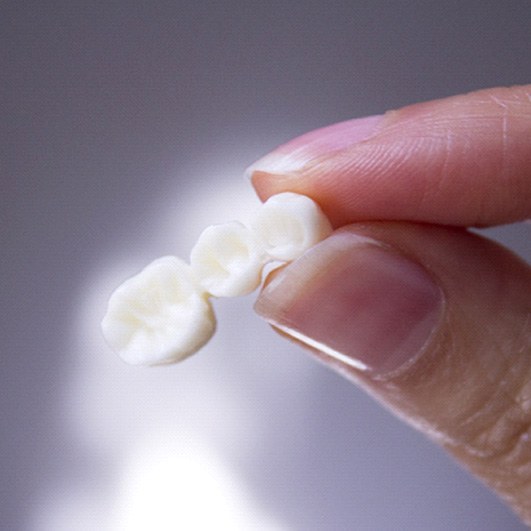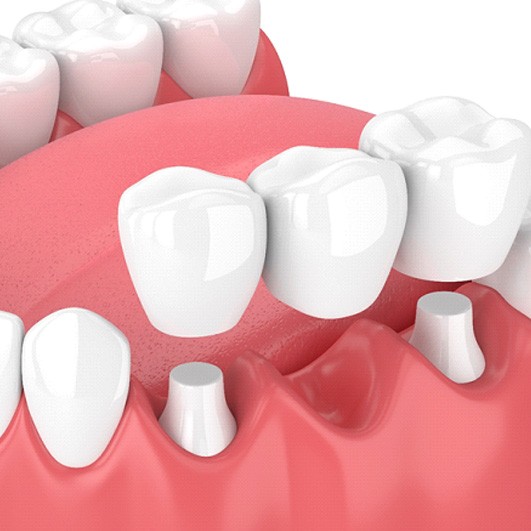Losing several pearly whites can often feel frustrating and awkward, especially when it comes to smiling confidently.
It can even make normal oral tasks challenging such as eating comfortably and speaking clearly. Fortunately, our
team at NU Dental Eatontown can replace consecutive missing teeth with dental bridges! These custom-made restorations can help you regain the look and function of your full smile. Not only are they indistinguishable from your natural teeth, but you’ll be able to enjoy them for many years to come. Feel free to give our team a call today or read on if you wish to learn more about this treatment!
What Is a Dental Bridge?

This type of restoration is specifically designed to replace consecutive missing teeth—usually between one and
four in a row. The dental bridge consists of two crowns that are anchored by adjacent teeth on either side of the
gap. This allows them to support the ones in between called the “pontics.” Your restoration will be
constructed out of durable, natural-looking dental materials like ceramic, that way it blends seamlessly with any
remaining pearly whites.
Types of Dental Bridges

The kind of dental bridge you’ll need will be influenced by the number of missing teeth and the location. Here are two types you can expect to receive for this treatment:
Traditional Dental Bridge
Patients who have strong and healthy pearly whites on either side of the gap can typically get a traditional bridge to restore their smile. This method may require a small amount of your enamel to be removed from the abutment teeth,that way the restoration can fit properly. A traditional dental bridge can usually be completed in only a few
appointments and tends to be the more affordable option.
Implant Bridge
If you don’t have reliable abutment teeth, then you may require a dental implant to be surgically embedded into
your jawbone first. These titanium posts will serve as your new permanent roots on either side of the gap, allowing
your bridge to be fitted securely. This option is also best if you have three or more missing teeth, as it
won’t have to rely on natural ones to remain firmly in place. Implant bridges generally last longer than
traditional ones, and they can help prevent further tooth loss.
The Benefits of Getting a Dental Bridge

Not only does a dental bridge close gaps in your smile, but it can also help keep dental shifting at bay. This
straightforward treatment prevents future misalignment issues, enhances both chewing ability and speech
articulation, and can preserve a more youthful jawbone structure if placed on dental implants. With this
cost-effective tooth-replacement option, you can be sure to enjoy your full smile for several years before needing a
touchup!
Dental Bridges FAQs
Can You Take a Dental Bridge Out?
No, dental bridges are designed to remain in your mouth for many years after being placed. You shouldn’t be able to take a bridge out on your own. Only a dental professional can. Some healthcare providers call partial dentures “removable bridges,” but this isn’t entirely accurate. Partials are similar to bridges, but one of the key differences is that partials can be removed by the patient at any time, while bridges stay put.
Is Getting a Dental Bridge Painful?
Just like when you get a filling, Dr. G will numb the area that he will be working on. While you shouldn’t feel anything during the procedure itself, you are likely to experience heightened sensitivity for a few days afterward. Fortunately, this can usually be managed with over-the-counter pain relievers. Because bridges keep your remaining teeth from shifting out of place, they may very well prevent discomfort later on caused by dental drift. If discomfort persists, give us a call!
How Many Teeth Can a Dental Bridge Replace?
Depending on the needs of the patient, a dental bridge can replace anywhere from one to four missing teeth in a row. However, in the majority of cases, bridges are only used to replace one or two teeth. The longer the bridge extends, the less stable it may become, especially if the natural teeth supporting the bridge aren’t strong and healthy. Ultimately, it can become risky to have a bridge replace three or more teeth. Implant bridges can lower this risk, as implants are just as strong and secure as natural teeth.
Do Dental Bridges Look Natural?
Metal-free bridges are made from materials that can be color-matched to your other teeth. These materials look remarkably similar to tooth enamel, even in the way that light bounces off of them. Once placed, your bridge should blend in seamlessly with the rest of your smile. Bridges remain stationary as well because they are anchored onto healthy teeth or dental implants, so you don’t need to worry about your bridge shifting around as an ill-filling denture might.


 (732) 863-3899
(732) 863-3899

